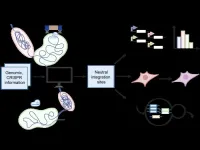(Press-News.org) University of Leeds Press Release
Under embargo until 10:00 GMT on 13 February
There are graphics and photographic images that help explain this story – see under Note to editors
Greenland’s ice sheet is melting - and being replaced by vegetation
An estimated 11,000 sq miles or 28,707 sq kilometres of Greenland’s ice sheet and glaciers have melted over the last three decades, according to a major analysis of historic satellite records.
The total area of ice loss is equivalent to the size of Albania, and represents about 1.6 % of Greenland’s total ice and glacier cover.
Where there was once ice and snow, there is now barren rock, wetlands and areas of shrub.
A team of scientists from the University of Leeds, who have tracked the changes across Greenland from the 1980s through to the 2010s, say warmer air temperatures are causing the ice to retreat, which in turn is having an impact on the temperature of the land surface, greenhouse gas emissions and the stability of the landscape.
Permafrost - a permanently frozen layer below the Earth’s surface - is being “degraded” by the warming and in some areas, the scientists warn that it could have an impact on the infrastructure, buildings and communities that exist above it.
Their findings - “Land cover changes across Greenland dominated by a doubling of vegetation in three decades” - are reported today (13/02) in the journal Scientific Reports.
Impact of global warming
Greenland is part of the Arctic region. It is the world’s biggest island, around 836,330 sq miles in size (2.1 million sq km). Most of the land is covered by ice and glaciers and it is home to almost 57,000 people.
Since the 1970s, the region has been warming at double the global mean rate. On Greenland, average annual air temperatures between 2007 and 2012 were 3 degrees C warmer, compared with the 1979 to 2000 average.
And the researchers warn that more extreme temperatures are likely in the future.
Jonathan Carrivick, an Earth scientist based in the Faculty of Environment at Leeds and one of the authors of the study, said: “Warmer temperatures are linked to the land cover changes that we are seeing on Greenland.
“By analysing high resolution satellite images, we have been able to produce a detailed record of the land cover changes that are taking place.”
Ice disappears to be replaced by bare rock and shrubs
Ice loss was concentrated around the edges of present-day glaciers but also in the north and south- west of Greenland. There were also high-levels of ice loss in localised areas in the west, mid-north-west and south-east.
Over the three decades, the amount of land with vegetation growing on it increased by 33,774 sq miles (87,475 sq km), more than doubling over the study period.
A pronounced increase in vegetation was seen across the south-west, east and north-east. The greatest increase in dense wetland vegetation occurred in the vicinity of Kangerlussuaq in the south-west and in isolated areas in the north-east.
Analysis by the researchers revealed that vegetation had increased along a latitudinal gradient between 63 degrees North and 69 degrees North and declined north of this.
Jonathan Carrivick said: "We have seen signs that the loss of ice is triggering other reactions which will result in further loss of ice and further ‘greening’ of Greenland, where shrinking ice exposes bare rock that is then colonised by tundra and eventually shrub.
“At the same time, water released from the melting ice is moving sediment and silt, and that eventually forms wetlands and fenlands.”
Loss of ice triggers further warming
The loss of ice affects land surface temperatures because of albedo, which is the measure of how reflective a surface is.
Snow and ice are good reflectors of the sun’s energy hitting the Earth’s surface and this helps to keep the Earth cooler. As the ice retreats, it exposes bedrock which absorbs more solar energy, raising the temperature of the land surface.
Similarly, as ice melts it increases the quantity of water in lakes. Water absorbs more solar energy than snow and this also increases the temperature of the land surface.
Greenhouse gas emitter
The analysis shows a near quadrupling of wetlands across Greenland, particularly in the east and north-east. The wetlands are a source of methane emissions.
Writing in the paper, the researchers noted: “Expansion of vegetation and especially in wetland areas indicates but also exacerbates permafrost thaw, active layer thickening and thus emissions of greenhouse gases previously stored in these Arctic soils.”
The researchers also developed a model to predict those areas on Greenland that are likely to see “marked and accelerated” change in the future.
Dr Michael Grimes, the lead author of the report who conducted the research as part of their PhD, added: “The expansion of vegetation, occurring in tandem with the retreat of glaciers and the ice sheet, is significantly altering the flow of sediments and nutrients into coastal waters.
“These changes are critical, particularly for the indigenous populations whose traditional subsistence hunting practices rely on the stability of these delicate ecosystems.
“Moreover, the loss of ice mass in Greenland is a substantial contributor to global sea level rise, a trend that poses significant challenges both now and in the future.”
Ends
Notes to editors:
Images and graphic illustrating the research available here.
Graphic caption:
Comparison between landcover classifications for the late 1980s and for the late 2010s at *30m resolution* reveals greening as vegetation coverage expands, especially in the south-west and north-east.
*The landcover analysis was done on a grid (the satellite images analysed are composed of a regular grid of pixels) and each pixel of the grid is a 30m by 30m square.
Captions for photographic images as follows:
IMGP9853.jpg: Russell Glacier and proglacial area, near Kangerlussuaq, west Greenland, courtesy of Jonathan Carrivick
DJI_0617: proglacial area of Fan Glacier, Qaanaaq, NorthWest Greenland showing braided proglacial stream, courtesy of Mark Smith
DJI_0869: from above Sydgletscher looking to Bowdoin Fjord, at Qaanaaq, north-west Greenland, courtesy of Mark Smith
For media enquiries or interview requests, please contact Kersti Mitchell via k.mitchell@leeds.ac.uk
University of Leeds
The University of Leeds is one of the largest higher education institutions in the UK, with more than 39,000 students from more than 137 different countries. We are renowned globally for the quality of our teaching and research.
We are a values-driven university, and we harness our expertise in research and education to help shape a better future for humanity, working through collaboration to tackle inequalities, achieve societal impact and drive change.
The University is a member of the Russell Group of research-intensive universities, and is a major partner in the Alan Turing, Rosalind Franklin and Royce Institutes www.leeds.ac.uk
Follow University of Leeds or tag us in to coverage: Twitter | Facebook | LinkedIn | Instagram
END
Greenland’s ice sheet is melting - and being replaced by vegetation
2024-02-13
ELSE PRESS RELEASES FROM THIS DATE:
New Durham University research opens avenues for more efficient and stable blue OLED displays
2024-02-13
-With pictures-
A new research from scientists at Durham University reveals an unexpected pathway towards brighter, more efficient, and more stable blue organic light-emitting diodes (OLEDs).
The findings, published in the journal Nature Photonics could help enable the next generation of energy-saving display technologies.
OLED displays, used in most modern smartphones and TVs, rely on light emission from specialised organic molecules.
Obtaining stable, efficient blue emission suitable for displays remains a key challenge.
Now, Durham ...
Study finds childhood bullying linked to distrust and mental health problems in adolescence
2024-02-13
A new study, co-led by UCLA Health and the University of Glasgow, found that young teenagers who develop a strong distrust of other people as a result of childhood bullying are substantially more likely to have significant mental health problems as they enter adulthood compared to those who do not develop interpersonal trust issues.
The study, published in the journal Nature Mental Health on Feb. 13, is believed to be the first to examine the link between peer bullying, interpersonal distrust, and the subsequent development of mental health problems, such as anxiety, depression, hyperactivity and anger.
Researchers ...
Compounds released by bleaching reefs promote bacteria, potentially stressing coral further
2024-02-13
On healthy reefs around the world, corals, algae, fishes and microbes live interconnected and in balance—exchanging nutrients, resources, and chemical signals. New research led by the University of Hawai‘i (UH) at Mānoa and and the Royal Netherlands Institute for Sea Research (NIOZ) revealed that when coral bleaching occurs, corals release unique organic compounds into the surrounding water that not only promote bacterial growth overall, but select for opportunistic bacteria that may further stress reefs.
“Our results demonstrate how the impacts of both short-term thermal ...
Short corrective comments can help social media user to spot false information, study shows
2024-02-13
Short and simple comments from ordinary social media users can help others online to spot fake news, a new study shows.
Research shows reading corrections from others online can reduce the perceived accuracy of and engagement with incorrect content.
Experts found the format and strength of corrective comments do not matter much. Social media users do not need to write long and detailed comments to flag false content.
While the study shows the general effectiveness of social correction, it also finds ...
Biomarker-directed combination effective in immunotherapy-resistant lung cancer
2024-02-13
HOUSTON ― A specific combination of targeted therapy and immunotherapy may better help patients with non-small cell lung cancer (NSCLC) overcome inherent immune resistance and reinvigorate anti-tumor activity, according to a new study led by a researcher from The University of Texas MD Anderson Cancer Center.
Results from the Phase II umbrella HUDSON study, published today in Nature Medicine, demonstrated that the anti PD-L1 antibody, durvalumab, coupled with the ATR inhibitor, ceralasertib, provided the greatest clinical benefit of four combinations evaluated.
This pair had an objective response ...
Plant-based diet tied to improved sexual health in men treated for prostate cancer
2024-02-13
A diet that limits meat and dairy but is rich in fruits, vegetables, grains, and nuts is linked to less erectile dysfunction, urinary incontinence, and other common side effects seen in prostate cancer patients, a new study shows.
Led by researchers at NYU Grossman School of Medicine and Harvard T.H. Chan School of Public Health, the analysis of more than 3,500 men with prostate cancer explored whether eating a more plant-based diet was associated with quality-of-life issues that often arise after treatment. Sorting patients into five groups (quintiles) based on the proportion of plant versus animal foods the men said they eat, the authors found ...
Quality of care for patients who call 911 varies greatly across the United States, study finds
2024-02-13
Emergency medical service (EMS) systems are not consistently providing optimal care based on new national standards of quality to patients who call 911, according to a new study from the Icahn School of Medicine of Mount Sinai.
The study demonstrates that EMS performance on key clinical and patient safety measures varies widely across urban and rural communities. The findings, published in the peer-reviewed Prehospital Emergency Care, identify opportunities that could lead to improved care during 911 responses and improved outcomes for patients across the United States.
“EMS systems in the United States have traditionally relied ...
CRISPR-copies: New tool accelerates and optimizes genome editing
2024-02-13
CRISPR/Cas systems have undergone tremendous advancement in the past decade. These precise genome editing tools have applications ranging from transgenic crop development to gene therapy and beyond. And with their recent development of CRISPR-COPIES, researchers at the Center for Advanced Bioenergy and Bioproducts Innovation (CABBI) are further improving CRISPR’s versatility and ease of use.
“CRISPR-COPIES is a tool that can quickly identify appropriate chromosomal integration sites for genetic engineering in any organism,” said Huimin Zhao, CABBI Conversion Theme Leader ...
Teenagers need better reproductive health education to tackle parenthood fears
2024-02-13
Nearly half of teenagers are worried about having children and many lack knowledge about their reproductive health, find two new studies by UCL researchers.
The studies, published in Human Fertility and Health Education Journal, used survey results from 931 students in England aged 16 to 18, collected between May 2021 and July 2022.
The Human Fertility paper found that a majority of students (64%) still wanted to have children in the future – with nearly half (49%) desiring to have two children.
However, 45% of all participants said that they had concerns about future ...
Data-driven app results in 25% fewer emergency hospital admissions from care homes
2024-02-13
The use of a digital remote monitoring technology in care homes has been found to reduce hospital A&E attendances by 11% and emergency admissions by 25% in a new study from the Health Data Research UK (HDR UK) Better Care programme, published today in Age and Ageing - the official journal of the British Geriatrics Society.
There are over 400,000 people living in care homes across the UK, many of whom will be living with complex medical needs that put them at greater risk of needing emergency healthcare, especially during the winter months.
Through the HDR UK Better Care programme, a collaboration between the universities ...


